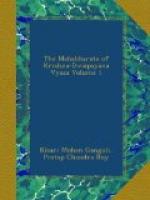then once more put forth his prowess of illusion.
The Ten-faced, producing from his body numerous warriors
resembling, O Bharata, both Rama and Lakshmana, rushed
towards the two brothers. And then those Rakshasas,
hostile to Rama and Lakshmana and armed with bows
and arrows, rushed towards Rama, and beholding that
power of illusion put forth by the king of Rakshasas,
that descendant of Ikshwaku’s race, the son
of Sumitra, addressed Rama in these heroic words,
‘Slay those Rakshasas, those wretches with forms
like thy own!’ And Rama, thereupon slew those
and other Rakshasas of forms resembling his own.
And that time Matali, the charioteer of Indra, approached
Rama on the field of battle, with a car effulgent
as the Sun and unto which were yoked horses of a tawny
hue. And Matali said, ’O son of Kakutstha’s
race, this excellent and victorious car, unto which
have been yoked this pair of tawny horses, belonging
to the Lord of celestials! It is on this excellent
car, O tiger among men, that Indra hath slain in battle
hundreds of Daityas and Danavas! Therefore, O
tiger among men, do thou, riding on the car driven
by me, quickly slay Ravana in battle! Do not
delay in achieving this!’ Thus addressed by him,
the descendant of Raghu’s race, however, doubted
the truthful words of Matali, thinking this is another
illusion produced by the Rakshasas—Vibhishana
then addressed him saying, ’This, O tiger among
men, is no illusion of the wicked Ravana! Ascend
thou this chariot quickly, for this, O thou of great
effulgence, belongeth to Indra!’ The descendant
of Kakutstha then cheerfully said unto Vibhishana,
‘So be it’, and riding on that car, rushed
wrathfully upon Ravana. And when Ravana, too,
rushed against his antagonist, a loud wail of woe
was set up by the creatures of the Earth, while the
celestials in heaven sent forth a leonine roar accompanied
by beating of large drums. The encounter then
that took place between the Ten-necked Rakshasa and
that prince of Raghu’s race, was fierce in the
extreme. Indeed, that combat between them hath
no parallel elsewhere. And Rakshasa hurled at
Rama a terrible javelin looking like Indra’s
thunderbolt and resembling a Brahmana’s curse
on the point of utterance.[104] Rama, however, quickly
cut into fragments that javelin by means of his sharp
arrows. And beholding that most difficult feat,
Ravana was struck with fear. But soon his wrath
was excited and the Ten-necked hero began to shower
on Rama whetted arrows by thousands and tens of thousands
and countless weapons of various kinds, such as rockets
and javelins and maces and battle-axes and darts of
various kinds and Shataghnis and whetted shafts.
And beholding that terrible form of illusion displayed
by the Ten-necked Rakshasa, the monkeys fled in fear
in all directions. Then the descendant of Kakutstha,
taking out of his quiver an excellent arrow furnished
with handsome wings and golden feathers and a bright
and beautiful head, fixed it on the bow with Brahmastra




